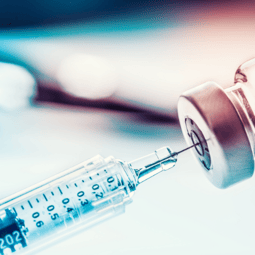 SPECIAL EDITION | Coronavirus & Comp Updates
SPECIAL EDITION | Coronavirus & Comp Updates
Read the full 4-part Workers’ Comp and COVID-19 Update.
The Virginia Workers’ Compensation Commission has awarded medical and indemnity benefits for adverse reactions to vaccines given to prevent the flu, tuberculosis, Hepatitis B, and smallpox. In those cases, the Commission evaluated whether the vaccine was an inherent risk of employment and whether the vaccine caused the claimant’s symptoms.
To determine whether a side effect of a vaccine constitutes a compensable injury by accident, the Commission considers factors including:
- whether the alleged side effect can be medically linked to the vaccine;
- whether the vaccine was required by the employer; and
- whether the vaccine was encouraged by the employer.
CASE LAW ANALYSIS
4 cases where claims of vaccine-related workplace injury were evaluated
CASE NO. 1 | COMPENSABLE
In Overton v. Augusta Correctional Center[1], correctional officers were regularly exposed to blood, urine, and feces at work. Due to these exposures the employer required the claimant to attend a meeting about blood borne pathogens. During the mandatory meeting, the claimant chose to receive a Hepatitis B vaccine and was given the shot. Within two days, the claimant began to suffer various symptoms which his treating physician unequivocally related to the hepatitis vaccine. In its 1994 Opinion, the Commission held that the claimant’s reaction to the vaccine was a sudden mechanical change at a reasonably definite time and held that he had suffered a compensable injury by accident.
Although the claimant in Overton was given the vaccine at a mandatory meeting, the Commission found that the claimant had the right to reject the vaccine. The Commission focused on the medical evidence and the causal relationship between the vaccine and claimant’s symptoms. The Commission did not explain what led it to conclude that claimant’s injury arose out of employment and was entirely silent on that point.
CASE NO. 2 | COMPENSABLE
In Dempsey v. Henrico Fire, the Commission held that a firefighter’s allergic reaction to a tuberculin vaccine was a compensable injury by accident.[2] The employer required that the claimant receive the vaccine during his employment physical. The claimant’s arm became red and swollen after the injection and there was no evidence that the reaction was caused by anything other than the vaccine. The employer argued that the vaccine could not be an accidental injury because the injection was performed purposefully. The Commission disagreed, finding that the reaction to the injection was an unintended consequence, and that claimant’s symptoms were related to the vaccine.
The Commission found that the claimant received the vaccine because it was required by his employer. It found that the procedure clearly occurred in the scope of claimant’s employment duties, and claimant’s reaction was a natural consequence of the injection. As a result, the Commission held that claimant’s adverse reaction to the vaccine was an accidental injury which arose out of and in the course of claimant’s employment.
CASE NO. 3 | COMPENSABLE
In Eysenbach v. Old Dominion University, the Commission awarded benefits to a nurse after she suffered an adverse reaction to a flu vaccine that she was given at work.[3] The claimant testified that she received the flu shot to protect her patients, because she regularly examined pregnant patients and patients with diabetes, HIV-AIDS, and other high risk conditions. Immediately after receiving the shot, the claimant felt pain in her arm which progressed over the next six weeks until she had difficulty lifting her arm. The employer strongly recommended the flu shot, but did not require it. The employer argued that claimant’s decision to receive the flu shot was personal and voluntary so any reaction to the shot was not caused by a risk of the employment.
Although both parties testified that the vaccine was voluntary, the Commission stated that the evidence was clear that the claimant was more than a volunteer. Rather, the claimant received the flu shot at the direction of her employer to better and more safely provide health care services to the employer’s customers. As a result, the Commission found the claimant’s injury to be compensable.
CASE NO. 4 I NOT COMPENSABLE
In Yambling v. Sentara Healthcare, Inc., the claimant, a hospital maintenance mechanic, was given a tetanus vaccine during a required medical screening at the employer’s occupational health department. [4] Before receiving the injection, the claimant signed a form stating that he was voluntarily requesting the vaccine. At the hearing, the claimant testified that he thought he was required to get the tetanus injection. The employer presented evidence that the injection was voluntary and not required. The Commission found that Claimant was not required to receive the injection and that the employer did not encourage the vaccination. The claimant was permitted to reject the immunization without consequence. The Commission stated that it would not penalize the employer for offering a service to its employees and denied Claimant’s claim, holding that his injury did not result from a work-related hazard.
Nothing about the tetanus shot in Yambling was inherently related to claimant’s employment, other than the fact that he happened to get it during his employment physical. The tetanus shot would not have prevented the claimant from spreading a disease to hospital patients the way the flu shot did in Eysenbach. Nothing about the tetanus shot in Yambling suggested that it was anything other than voluntary.
Practical Tips
4 cases where claims of vaccine-related workplace injury were evaluated
No. 1 | Compensability in vaccine cases is dependent on fact pattern
These cases demonstrate that the compensability analysis must be made on a case by case basis. As COVID-19 vaccines become more widely available to the workforce, it will be helpful to know if an employer required or recommended that employees receive the vaccine, or if it was truly voluntary. It will also be helpful to fully understand the claimant’s job description and related duties to assess whether the true benefit of the vaccine flows to the employer, as it did in the Eysenbach case.
No. 2 | Know what side-effects are being reported
Familiarity with the vaccine’s side effects and investigating when those side effects began will also aid your investigations on causation. Pfizer’s vaccine fact sheet[5][6] currently lists the most common adverse reactions as pain at the injection site, fatigue, headache, muscle pain, chills, joint pain, fever, injection site swelling, injection site redness, nausea, malaise, and lymphadenopathy. Pfizer also noted that severe allergic reactions have been reported during mass vaccination outside of clinical trials. Moderna[7] has reported similar reactions to its vaccine.
No. 3 | Link to Find Frequency of Reported Side-effects
The U.S. Vaccine Adverse Event Reporting System (“VAERS”) tracks serious adverse events, among other things. The VAERS data is accessible here. As adverse events continue to be reported, it may be helpful to know how often a specific side effect has been reported.
VACCINE FACT SHEETS
- Pfizer-BioNTech COVID-19 Vaccine EUA Fact Sheet for HCP revised 01-06-2021
- Pfizer-BioNTech COVID-19 Vaccine EUA Fact Sheet for Recipients and Caregivers
- Moderna COVID-19 Vaccine EUA Fact Sheet for Healthcare Providers
- Modeena COVID-19 Vaccine EUA Fact Sheet for Recipients and Caregivers
No. 4 | Vaccine Safety - There’s an app for that
The V-safe app is a voluntary smartphone tool provided to vaccine recipients.[8] Recipients can report any side effects on the app, or directly to the FDA, or the manufacturers. It will be helpful to find out if the claimant downloaded the V-safe app, and whether they reported any symptoms through the app, or directly to the vaccine manufacturers, providers, to the FDA, or to a doctor.
[1] Overton v. Commonwealth of Virginia/Augusta Correctional Center, VWC File No. 161-10-26 (Jul. 1, 1994).
[2] Dempsey v. Henrico Fire, VWC File No. 196-40-41 (Dec. 12, 2000), Aff’d by Court of Appeals Record No. 0086-01-2 (Nov. 27, 2001)(unpublished).
[3] Eysenbach v. Old Dominion University, VWC File No. 208-70-64 (Nov. 15, 2002).
[4] Yambling v. Sentara Healthcare, Inc., VWC File No. 211-49-86 (May 3, 2004)
Read the full 4-part Workers’ Comp and COVID-19 Update.
Part 1 - A ‘Disease’
Part 2 - Similarities with a Tuberculosis Case
Part 3 - First Responder Presumption Cases
 Workers’ Compensation Practice Group at McCandlish Holton defends workers’ compensation claims in all areas of Virginia from initial investigation to the trial and appellate levels of litigation.
Workers’ Compensation Practice Group at McCandlish Holton defends workers’ compensation claims in all areas of Virginia from initial investigation to the trial and appellate levels of litigation.
Our experienced team provides innovative legal strategies tailored to the needs of your claims. We carefully balance aggressive advocacy with skilled diplomacy to successfully resolve claims. Contact Us.


